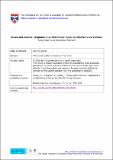Bread and cinema : Baghdad in al-Nakhla wa-'l-jiran by Gha'ib Tu'ma Farman
Abstract
Al-Nakhla wa-'l-jīrān (‘The Palm Tree and the Neighbours', 1966) has been largely neglected outside the Arab world, despite being hailed as ‘the true beginning’ of the Iraqi novel. After an introduction to Farmān and the intellectual climate in which he started writing, the article goes on to discuss: the sophisticated realism of the novel, by contrasting it to that of its alleged sources, including Naguib Mahfouz's Zuqāq al-midaqq; and the depiction of Baghdad through a detailed analysis of how space is evoked in the text (with reference to the readings of the novel by Arab critics and also to the writings of Auerbach and Bachelard). The representations of Baghdad range from lyrical evocations to humorous and poignant dramatisations of the city during the British occupation in World War II. Space is seen lived, imagined and reinvented by its inhabitants through traditional storytelling and the world of cinema in a way that gives life and meaning to the much abused literary term of realism.
Citation
Caiani , F & Cobham , C M 2010 , ' Bread and cinema : Baghdad in al-Nakhla wa-'l-jiran by Gha'ib Tu'ma Farman ' , Middle Eastern Literatures , vol. 13 , no. 3 , pp. 231-259 . https://doi.org/10.1080/1475262X.2010.523203
Publication
Middle Eastern Literatures
Status
Peer reviewed
ISSN
1475-262XType
Journal article
Collections
Items in the St Andrews Research Repository are protected by copyright, with all rights reserved, unless otherwise indicated.

